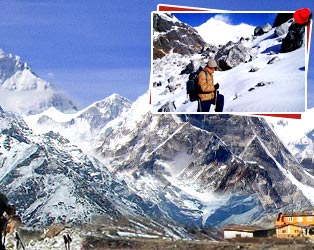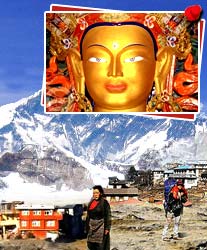The five main rivers of the Himalayas are the Jhelum,
Chenab, Ravi, Beas, and Sutlej. The Himalayas is the birthplace of many
important rivers. The rivers of the Himalayas give a new dimension to
the beautiful scenic beauty of the Himalayan region. The rivers are the
main source of life in those areas. It helps in the formation of the
forest belt and irrigation process in these regions.
Jhelum River
The river Jhelum originates from a spring called Verinag, which is 80
km south of Srinagar. It is known world wide for its pictorial beauty
and nine bridges. It is a very wide river and has muddy water. It flows
through Srinagar.
Chenab River
The two rivers Chandra and Bhaga merge to form the Chenab River. The
Chenab is found in the Lahaul region of Himachal Pradesh. It originates
from the snows found at the foot of the main range of Himalaya in the
Spiti and Lahaul district. The beautiful lake of Chandra Tal originates
from these rivers.
Ravi River
With this river lots of love legends are associated. The town of Chamba
is situated on a mountain shelf on the right bank of the river. The
region is famous for handicrafts like embroidered handkerchiefs, silver
and leather craft and woodcarving.
Beas River
The valley of Kullu and Kangra is formed by river Beas. It is famous
for its b eauty. But the river mainly originates from a structure like
igloo near Rohtang Pass in Pir Panjal range to the north of Kullu. The
main force of this river is towards south of Larji and then towards the
west. There it enters the Mandi district and further still into Kangra.
All its tributaries are perennial because it is snow fed. Its water
increases to a great extent during the monsoon season so much so that it
causes floods in its surrounding areas. The Pong Dam is constructed on
the river to generate hydroelectric power supply. At a place called
Pandoh in the Mandi district the water of the Beas River have been
diverted through a 53 km long tunnel to the Sutlej.
Sutlej River
River Sutlej originates from the southern slopes of the holy mountain
Kailash, near the lake of Mansarovar. It flows parallel to the Himalayas
and finally penetrates to the Shipki pass. It cuts through the Zanskar
range, and makes a deep gorge at the base of the Kinner Kailash massif.
Within Kinnaur district, it runs parallel to the Hindustan-Tibet Road.
Later at Karcham, in Kinnaur, it is joined by river Baspa that drains
the Sangla valley.
Among the other important Himalayan Rivers are Indus River, Ganga
River, Yamuna River, Brahmaputra River and Spiti River.
Indus River
It originates near the Mansarovar Lake on the Tibetan plateau. It meets
with River Gurtang at an altitude of 4,200 m in the southeastern Ladakh,
where it enters the Himalayas. Then it follows the northwest course
between the Ladakh range in the north and the Zanskar Range in the
south. Places like Leh, Marol, Skardu and Bunji have grown along the
Indus River in Ladakh.
Ganga River
Ganga River is considered the holy river of India. In Hindu religion it
is held in high regard. Ganga or the Ganges is the holiest of all
rivers. It is a perpetual river, which originates from the Gangotri
Glacier located at 14,000 ft at the foothills of the Himalayas in north
Uttar Pradesh. River Bhagirathi, which joins with Alaknanda, to form
river Ganga at the town of Devprayag. It is considered as one of the
most auspicious and holy river of India.
Yamuna River
The origin of river Yamuna or Jamuna is from the Bundar Poonch glaciers
located in the district of Uttarkashi of the state of Uttaranchal. It
grows from Jamunotri, in the Himalayas. The river flows towards the
south direction through the Himalayan foothills and onto the plains of
north India along the Uttar Pradesh and Haryana State border.
Brahmaputra River
Brahmaputra River is considered as one of the great rivers of Asia. It
starts its 3000 km journey from the slopes of Kailash in western Tibet
to the Bay of Bengal. It commences as Tibet's great river the Tsangpo,
and then it finally turns south where it emerges in Arunachal Pradesh as
the Dihong. Just beyond Pasighat, it meets the Dibang and Lohit where it
finally becomes the Brahmaputra. This is the course of the river
Brahmaputra.
Spiti River
The Spiti River originates from the Kunzum Pass, which is 16,000 ft
high. The valley of Spiti is named after this river. It joins the Sutlej
River near the village of Namgiya in Kinnaur district after flowing for
about 60 miles.



